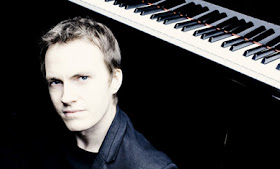The French pianist plays, then talks to Superconductor.
by Paul Pelkonen
by Paul Pelkonen
 |
| A man and his keys Alexandre Tharaud |
The words "piano recital" conjure images of the big stage, a jet-black Steinway grand under a bright spotlight. For pianist Alexandre Tharaud, his April 9 recital at Le Poisson Rouge had a very different atmosphere. Mr. Tharaud took the stage with a lean, casual grace, casting spells with longkh fingers on the (baby) grand in the underground Greenwich Village club.
The next day, those fingers are wrapped around a paper cup of green tea, in the back of a Seventh Avenue café. "It's cold back here," he says as he sits down for an interview, part of a run of New York press to promote his forthcoming record, Le Boeuf sur le Toit.
 |
| Promotional card for the Paris cabaret and café Le Boeuf sur le Toit. |
Mr. Tharaud's new disc (arriving in September of this year) is a homage to the French cabaret of that name, founded in 1921 by the playwright Jean Cocteau. Named after the 1920 composition by Darius Milhaud, a member of the French composition school Les Six, the café was a rendezvous for Paris' composers, artists and intelligentsia, attracting Stravinsky, Diaghalev and Maurice Ravel. It also served to introduces Paris music-lovers to American jazz.
Mr. Tharaud explains. "I was twelve years old, when I got a box with two records--the black ones," he recalls. Those records included Gershwin, Porter and piano pieces by Jean Wiener, an whose Blues led off the third part of Monday night's concert. "I was sure that one day I would record those piano pieces."
The evening at Le Poisson Rouge breathed some of that rarified atmosphere. The audience included Natalie Dessay, the current Violetta in the Met's production of La Traviata and a slew of music industry and journalistic cognoscenti. Mr. Tharaud opened with elegant readings of five Scarlatti sonatas, five works plucked from that composer's enormous catalogue.
"When I recorded the tribute to Scarlatti," he says setting aside his tea (barely touched), "It was overwhelming. There are more than 600 sonatas. Finally, after months and months I decided to record 18 sonatas." He adds: "I wanted to do a collection of sonatas with very different styles. Some are virtuoso pieces, others, operatic arias. Others are dances: inspired by the gavotte, the minuet, and flamenço. My CD was...how do you say...a bouquet of different styles."
"When you pick just five pieces," he explains, "the sonatas form a cycle. With surprises, with turnings, with shocks. It's very important--you heard a lot of changes between the sonatas and the different styles."
Mr. Thaurad devoted the next part of his recital to Debussy's Preludes, formidable works that are far from the image of the composer that exists in ppular culture. The preludes selected were fulled with dynamic shifts and powerful instrumentation, played not from the wrists, but from the shoulders.
"People don't realize, that these Debussy pieces are huge!" Mr. Thauraud enthuses. "The Preludes, with those passages (he hums a bit) ths is music for a very large, public space, difficult to play in a smaller room."
The final "set" consisted of four selections: the jazz part of the evening. Jean Wiener's Blues had an amiable, loping groove, the melody driven from the right hand. George Gershwin's The Man I Love showed the influence of Paris musicians on this uniquely American composer.
Mr. Tharaud followed with an unusual transcription: the 5 o'clock scene from Ravel's opera L'Enfant et les Sortileges. This work, a collaboration between the Swiss composer and the writer Colette, may have sprung whole from the dark corner tables of Le Boeuf sur le toit. The set ended with Clement Doucet's Chopinata, which transforms Paris' leading piano music composer of the 19th century into something that belongs uniquely to the 20th.
The evening ended with one last evocation of that famous cabaret. Mr. Tharaud asked the audience what they wanted to hear. From her seat down front, Ms. Dessay called out "Bach." The pianist obliged, with the Adagio movement of Johann Sebastian's Third Solo Concerto in D minor. Like the artist, it was played with peerless elegance.
